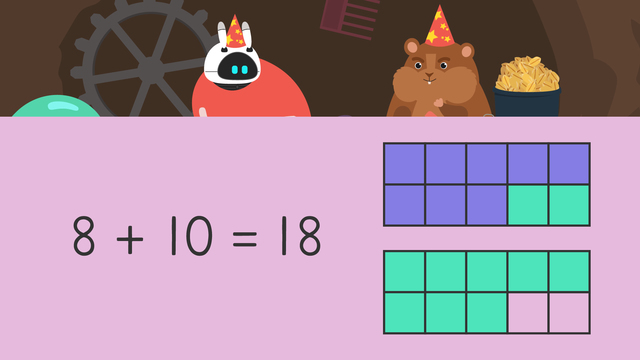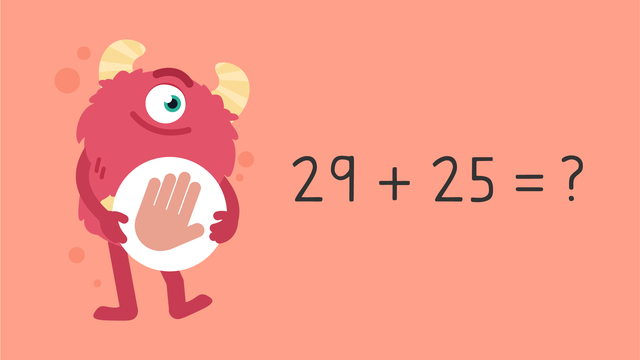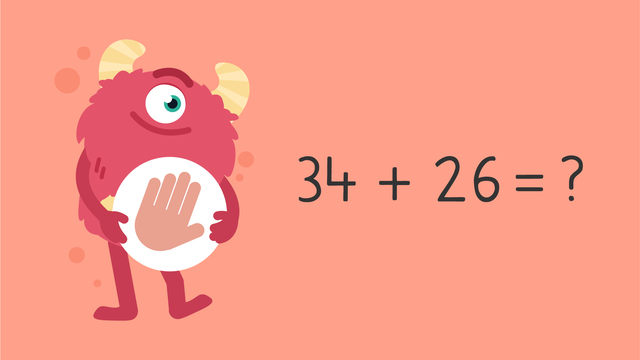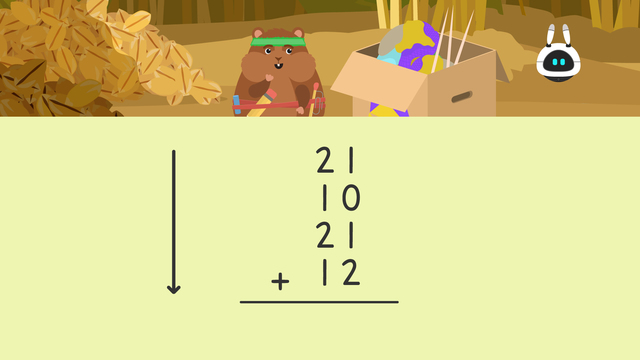Using Make Ten to Add
Basics on the topic Using Make Ten to Add
Making a Ten Strategy – Understanding Ten Frames
The ability to use appropriate tools when performing addition is critical for developing a deep understanding of addition operations. A ten frame is one such tool.
A ten frame is a rectangle with ten equal spaces, divided into two rows of five. It is used to represent numbers less than or equal to ten. Since ten frames contain ten equal spaces, they allow children to develop numbers sense and exchange skills within the base 10 number system. The ten frame can be used when using the make a ten addition strategy.
How to Use a Ten Frame
We use a ten frame by placing a single counter in each of the spaces to make the number. When adding, we can use ten frames to help us break up numbers and count on. A double-digit number can be broken up into the tens and ones. The tens place will fill up the ten frame.
For example, the number seventeen can be broken up into a ten and seven ones that can be shown on the ten frame
How to Use Make a Ten to Add
The ten frame can, therefore, be used to add larger numbers by breaking apart the smaller addend into tens and ones.
For example, if we are asked to add 38 and 15 we can do the following:
Step 1: Create a number sentence → 38 + 15
Step 2: Break apart the smaller addend and place it in the ten frame. The smaller addend is 15, therefore, 15 becomes 10 and 5
- Step 3: Solve using the ten frame by adding ten and counting on. Therefore, the complete ten frame combines with 38 to give us 48. Then, we count on from there using the second ten frame to get 53.
Ten Frames – Steps for Making Ten to Add
To use make a ten to add, we can follow these steps:
| Step | What to do |
|---|---|
| 1. | Create a number sentence. |
| 2. | Break apart the smaller addend. |
| 3. | Solve using the ten frame by adding to the bigger number in tens and then counting on. |
Making 10 to Add – Summary
Let’s repeat what we learned about ten frames and the strategy to make ten to add today.
Ten frames are useful tools in an addition strategy where the smaller addend can be broken apart into a ten and the smaller number represented on another ten frame. The ten frame can then be used to find the sum by counting in tens and then counting on. Because ten frames provide a visual representation of numbers, they allow children to make sense of ‘tens’ and ‘ones’
Frequently Asked Questions about Making 10 to Add
Transcript Using Make Ten to Add
: "The sun is so warm, it's perfect for this walk!" : "And look at these mushrooms!" Mr. Squeaks and Imani are out for a walk when Mr. Squeaks sees something that catches his eye. While exploring the mushrooms he suddenly realizes that he's lost! : (concerned, then lost) "Imani? IMANI!" Mr. Squeaks needs a strategy to help. He can add the different mushrooms to count his way back! Let's learn about "using make ten to add" to help Mr. Squeaks. There are different strategies that you can use to solve addition equations. One is to use 'make ten' when adding. You may know about the ten frame... and that when we fill all of the boxes, we have ten. Let's use the ten frame to add using 'make ten'! Mr. Squeaks first passed twenty-six red mushrooms and then fifteen purple mushrooms. How many mushrooms has he passed in total? We can start by creating an equation, or number sentence. Which is twenty-six plus fifteen. Next, take the smaller addend, we can break it apart to make smaller numbers. We can take fifteen and make it a ten and a five. Now we have twenty-six plus ten plus five, which may be easier to add. Then, solve using the ten frame. While there are different ways to add, in this video we will add by tens and count on. What is twenty-six plus ten? (...) Thirty-six. Now, we can add thirty-six plus five (...) which is forty-one. That means twenty-six plus fifteen equals forty-one. : "Okay, I've passed forty-one mushrooms, I can't be far." : (confused) "Wait, I didn't pass green mushrooms yet..." Mr. Squeaks just saw thirty-two green mushrooms and then twelve brown ones. How many mushrooms did he pass? Start by creating an equation. We can create thirty-two plus twelve. Next, take the smaller addend and break it apart to make it smaller. Here we can take twelve and make a ten and a two. Now we have thirty-two plus ten plus two. Then, solve using the ten frame. What is thirty-two plus ten? (...) forty-two! What is forty-two plus two? (...) forty-four! So, Mr. Squeaks has passed forty-four mushrooms. : "I MUST be close now!." : (incredulous and confused) "MORE MUSHROOMS?" We can use 'make ten' to help Mr. Squeaks one last time. Mr. Squeaks saw forty-seven spotted mushrooms and seventeen small ones. How many mushrooms should he add? Remember to start by creating an equation. We can create forty-seven plus seventeen. Next, take the smaller addend and break it apart to make it even smaller. Here we can take seventeen and make one ten and seven ones. Now we have forty-seven plus ten plus seven. What is forty-seven plus ten? (...) Fifty-seven What is fifty-seven plus seven? (...) Sixty-four. Mr. Squeaks needs to add sixty-four mushrooms to his list. Let's review! When using 'make ten' to add... start by creating an equation. Next, take the smaller addend and break it apart to make smaller addends. Don't forget to fill the ten frame with the smaller addends! Then, solve using the new equation. In this video we added by tens and counted on. Now, I wonder how Mr. Squeaks is doing... : "IMANI! I missed you! I thought I was lost forever!" : (worried) "I-imani? That's you, right?" : "Surprise! It's me!"
Using Make Ten to Add exercise
-
How do you use make ten to add?
HintsRemember, the first thing you need to do is understand what the problem is asking, and create an equation to show that in a math sentence.
Try adding 23 + 14 on your own. What steps did you follow?
SolutionFor Mr. Squeaks to teach Imani, he needs to show them these steps in this order.
-
Select the correct make tens equation.
HintsYou will break the number 23 (the smaller addend) into tens.
Think about the number 23. How many tens are in 20?
Solution27 + 23 would be 27 + 10 + 10 + 3. We split the smaller addend (23) into tens (20), with three ones left.
-
Match the pairs.
Hints14 + 11 in make 10 is 14 + 10 + 1.
Remember, in make 10, we break the smaller addend into tens and ones.
Example: 17 + 12 = 17 + 10 + 2
SolutionWhen we use make 10, we break the smaller number into tens and ones, like these pairs.
-
Show the steps.
HintsFirst, we need to break the smaller addend into tens and ones.
The smaller addend is 12.
For the first step, 12 would be broken into 10 + 2.
For the second step, add 18 + 10 to fill in the blank.
SolutionMr. Squeaks can use make 10 to find the answer! He will start by breaking the smaller addend into tens ( 18 + 10 + 2). Next, he will add the ten to the larger addend (28 + 2). Finally, he will add on the ones (30). The answer is 30.
-
How much in total?
HintsStart by adding the 10 to the larger addend. Then add on the ones.
Start with 31, and add on using the dots in the ten frame.
SolutionBy using make ten, we can add the numbers together.
31 + 10 + 7.
First, add the 31 + 10. 31 + 10 = 41.
Next, add the one place. 41 + 7 = 48.
The answer is 48.
-
Add the numbers.
HintsRemember, break the smaller addend (16) into tens and ones.
Add the ten to the larger number, then add the ones.
You are adding 43 + 10 + 6.
Solution43 + 16 = 59
First, Mr. Squeaks broke the smaller addend into tens and ones: 43 + 10 + 6
Then, he added the ten to the larger addend. 53 + 6
Finally,he added the ones to get the answer: 59

Order in Adding

Using Make Ten to Add

Compensation in Addition

Compensation in Addition — Let's Practice!

Subtract Using Addition — Let's Practice!

Make a Number Line to Add — Let's Practice!

Adding Four Two Digit Numbers

Using Place Value to Subtract (Regrouping)

Using Place Value to Add Two Digit Numbers (No Regouping)












